LAW101 Business Law Assignment: Contractual Issues
VerifiedAdded on 2022/10/04
|13
|3520
|22
Homework Assignment
AI Summary
This document presents a detailed solution to a contract law assignment, addressing two key scenarios. Part 1 analyzes a contract dispute between Flyways Airlines Ltd. and Boeing Corporation Ltd., focusing on the validity of an exclusion clause limiting Boeing's liability for a breach of contract concerning an aircraft's specifications. The analysis considers offer, acceptance, and the incorporation of the exclusion clause, concluding that the clause is likely invalid, and Boeing is liable for damages. Part 2 examines several potential contract disputes involving Bob and four other individuals (Mike, Tom, Steve, and Mary), applying contract law principles to determine whether Bob has a valid claim against each party. The analysis considers offer, acceptance, and consideration, and the postal rule in the context of contract formation. The solution provides legal arguments and case references to determine the outcome of each potential claim, ensuring that the reader understands the legal position of each party in the given scenarios.

Running head: CONTRACT LAW
CONTRACT LAW
Name of the Student:
Name of the University:
Author Note:
CONTRACT LAW
Name of the Student:
Name of the University:
Author Note:
Paraphrase This Document
Need a fresh take? Get an instant paraphrase of this document with our AI Paraphraser
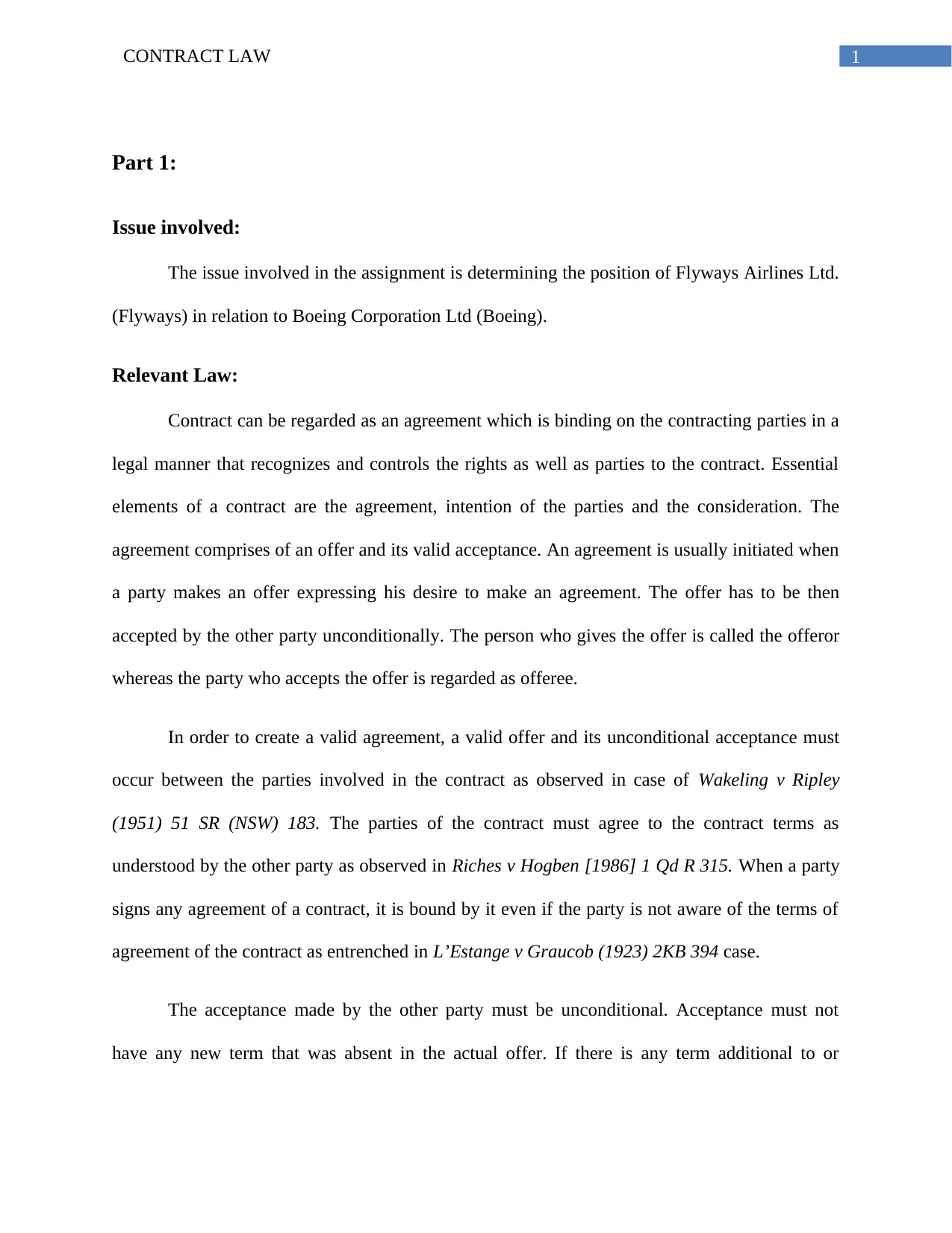
1CONTRACT LAW
Part 1:
Issue involved:
The issue involved in the assignment is determining the position of Flyways Airlines Ltd.
(Flyways) in relation to Boeing Corporation Ltd (Boeing).
Relevant Law:
Contract can be regarded as an agreement which is binding on the contracting parties in a
legal manner that recognizes and controls the rights as well as parties to the contract. Essential
elements of a contract are the agreement, intention of the parties and the consideration. The
agreement comprises of an offer and its valid acceptance. An agreement is usually initiated when
a party makes an offer expressing his desire to make an agreement. The offer has to be then
accepted by the other party unconditionally. The person who gives the offer is called the offeror
whereas the party who accepts the offer is regarded as offeree.
In order to create a valid agreement, a valid offer and its unconditional acceptance must
occur between the parties involved in the contract as observed in case of Wakeling v Ripley
(1951) 51 SR (NSW) 183. The parties of the contract must agree to the contract terms as
understood by the other party as observed in Riches v Hogben [1986] 1 Qd R 315. When a party
signs any agreement of a contract, it is bound by it even if the party is not aware of the terms of
agreement of the contract as entrenched in L’Estange v Graucob (1923) 2KB 394 case.
The acceptance made by the other party must be unconditional. Acceptance must not
have any new term that was absent in the actual offer. If there is any term additional to or
Part 1:
Issue involved:
The issue involved in the assignment is determining the position of Flyways Airlines Ltd.
(Flyways) in relation to Boeing Corporation Ltd (Boeing).
Relevant Law:
Contract can be regarded as an agreement which is binding on the contracting parties in a
legal manner that recognizes and controls the rights as well as parties to the contract. Essential
elements of a contract are the agreement, intention of the parties and the consideration. The
agreement comprises of an offer and its valid acceptance. An agreement is usually initiated when
a party makes an offer expressing his desire to make an agreement. The offer has to be then
accepted by the other party unconditionally. The person who gives the offer is called the offeror
whereas the party who accepts the offer is regarded as offeree.
In order to create a valid agreement, a valid offer and its unconditional acceptance must
occur between the parties involved in the contract as observed in case of Wakeling v Ripley
(1951) 51 SR (NSW) 183. The parties of the contract must agree to the contract terms as
understood by the other party as observed in Riches v Hogben [1986] 1 Qd R 315. When a party
signs any agreement of a contract, it is bound by it even if the party is not aware of the terms of
agreement of the contract as entrenched in L’Estange v Graucob (1923) 2KB 394 case.
The acceptance made by the other party must be unconditional. Acceptance must not
have any new term that was absent in the actual offer. If there is any term additional to or

2CONTRACT LAW
contrary to that put forwarded by offeror, then the acceptance will not amount to a valid
acceptance and will be considered as the counter offer.
A counter offer is one which is made responding to the previous offer made by the other
party during the negotiation of the main contract. The counter offer is to be regarded as the fresh
offer without giving regard to the offer made before. A counter offer usually extinguishes the
former offer. This was observed in Hyde v Wrench [1840] EWHC Ch J90.
The party to the contract can limit or exclude his liability by use of an exclusion clause
and it is not a legal liability as given in the case of Chapelton v Barry Urban District Council
(1940) KB 532. An exclusion clause can be enumerated as a condition or statement mentioned in
any agreement of the contract which excludes/ limits the liability of one party to exercise his
duties in the contract. It has to be brought to the notice of the other party against whom it is to be
applied as observed in the case of Causer v Browne (1952) VLR 1. As given in the case of Thornton
v Shoe Lane Parking Ltd (1971) 2 QB 163 if the exclusion clause is not in the attention of the
other party which will be detrimental to him, in such case, the clause is not valid and binding.
Once a contract is created, no new term can be added to such contract which is observed in the
case of Interphoto Picture Library v Stiletto Visual Programmes Ltd (1988) 2 WLR 615.
A condition refers to the term in the contract which if violated by one of the parties, then
the other party has the right of terminating the contract and can ask for damages for loss incurred
by him for the breach by such party. On the other hand, warranty refers to the term that does not
provide a right or authority towards the suffering party to escape from his liability in a contract.
It forms less important terms related to a contract as such term does not form the contract’s
contrary to that put forwarded by offeror, then the acceptance will not amount to a valid
acceptance and will be considered as the counter offer.
A counter offer is one which is made responding to the previous offer made by the other
party during the negotiation of the main contract. The counter offer is to be regarded as the fresh
offer without giving regard to the offer made before. A counter offer usually extinguishes the
former offer. This was observed in Hyde v Wrench [1840] EWHC Ch J90.
The party to the contract can limit or exclude his liability by use of an exclusion clause
and it is not a legal liability as given in the case of Chapelton v Barry Urban District Council
(1940) KB 532. An exclusion clause can be enumerated as a condition or statement mentioned in
any agreement of the contract which excludes/ limits the liability of one party to exercise his
duties in the contract. It has to be brought to the notice of the other party against whom it is to be
applied as observed in the case of Causer v Browne (1952) VLR 1. As given in the case of Thornton
v Shoe Lane Parking Ltd (1971) 2 QB 163 if the exclusion clause is not in the attention of the
other party which will be detrimental to him, in such case, the clause is not valid and binding.
Once a contract is created, no new term can be added to such contract which is observed in the
case of Interphoto Picture Library v Stiletto Visual Programmes Ltd (1988) 2 WLR 615.
A condition refers to the term in the contract which if violated by one of the parties, then
the other party has the right of terminating the contract and can ask for damages for loss incurred
by him for the breach by such party. On the other hand, warranty refers to the term that does not
provide a right or authority towards the suffering party to escape from his liability in a contract.
It forms less important terms related to a contract as such term does not form the contract’s
⊘ This is a preview!⊘
Do you want full access?
Subscribe today to unlock all pages.

Trusted by 1+ million students worldwide
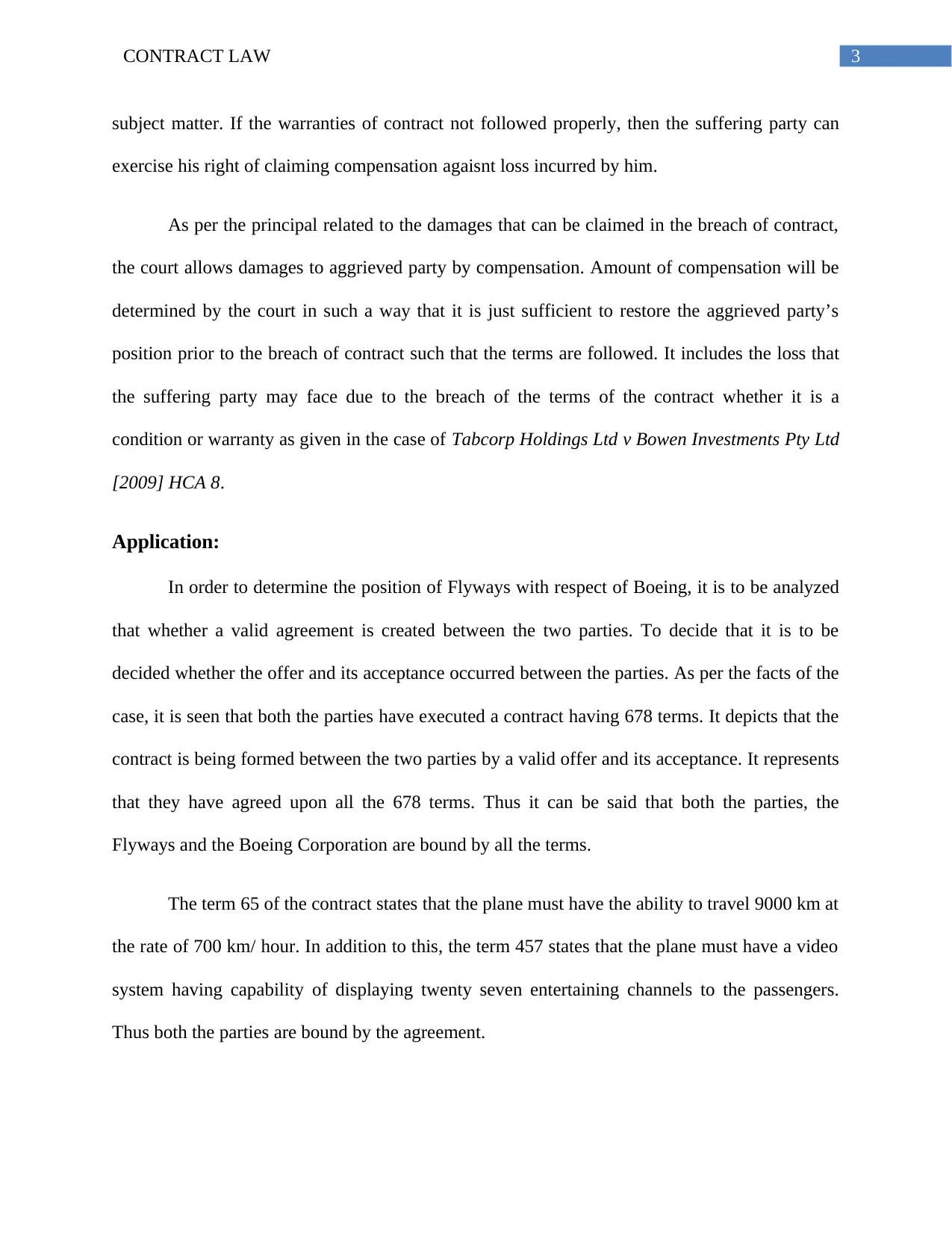
3CONTRACT LAW
subject matter. If the warranties of contract not followed properly, then the suffering party can
exercise his right of claiming compensation agaisnt loss incurred by him.
As per the principal related to the damages that can be claimed in the breach of contract,
the court allows damages to aggrieved party by compensation. Amount of compensation will be
determined by the court in such a way that it is just sufficient to restore the aggrieved party’s
position prior to the breach of contract such that the terms are followed. It includes the loss that
the suffering party may face due to the breach of the terms of the contract whether it is a
condition or warranty as given in the case of Tabcorp Holdings Ltd v Bowen Investments Pty Ltd
[2009] HCA 8.
Application:
In order to determine the position of Flyways with respect of Boeing, it is to be analyzed
that whether a valid agreement is created between the two parties. To decide that it is to be
decided whether the offer and its acceptance occurred between the parties. As per the facts of the
case, it is seen that both the parties have executed a contract having 678 terms. It depicts that the
contract is being formed between the two parties by a valid offer and its acceptance. It represents
that they have agreed upon all the 678 terms. Thus it can be said that both the parties, the
Flyways and the Boeing Corporation are bound by all the terms.
The term 65 of the contract states that the plane must have the ability to travel 9000 km at
the rate of 700 km/ hour. In addition to this, the term 457 states that the plane must have a video
system having capability of displaying twenty seven entertaining channels to the passengers.
Thus both the parties are bound by the agreement.
subject matter. If the warranties of contract not followed properly, then the suffering party can
exercise his right of claiming compensation agaisnt loss incurred by him.
As per the principal related to the damages that can be claimed in the breach of contract,
the court allows damages to aggrieved party by compensation. Amount of compensation will be
determined by the court in such a way that it is just sufficient to restore the aggrieved party’s
position prior to the breach of contract such that the terms are followed. It includes the loss that
the suffering party may face due to the breach of the terms of the contract whether it is a
condition or warranty as given in the case of Tabcorp Holdings Ltd v Bowen Investments Pty Ltd
[2009] HCA 8.
Application:
In order to determine the position of Flyways with respect of Boeing, it is to be analyzed
that whether a valid agreement is created between the two parties. To decide that it is to be
decided whether the offer and its acceptance occurred between the parties. As per the facts of the
case, it is seen that both the parties have executed a contract having 678 terms. It depicts that the
contract is being formed between the two parties by a valid offer and its acceptance. It represents
that they have agreed upon all the 678 terms. Thus it can be said that both the parties, the
Flyways and the Boeing Corporation are bound by all the terms.
The term 65 of the contract states that the plane must have the ability to travel 9000 km at
the rate of 700 km/ hour. In addition to this, the term 457 states that the plane must have a video
system having capability of displaying twenty seven entertaining channels to the passengers.
Thus both the parties are bound by the agreement.
Paraphrase This Document
Need a fresh take? Get an instant paraphrase of this document with our AI Paraphraser
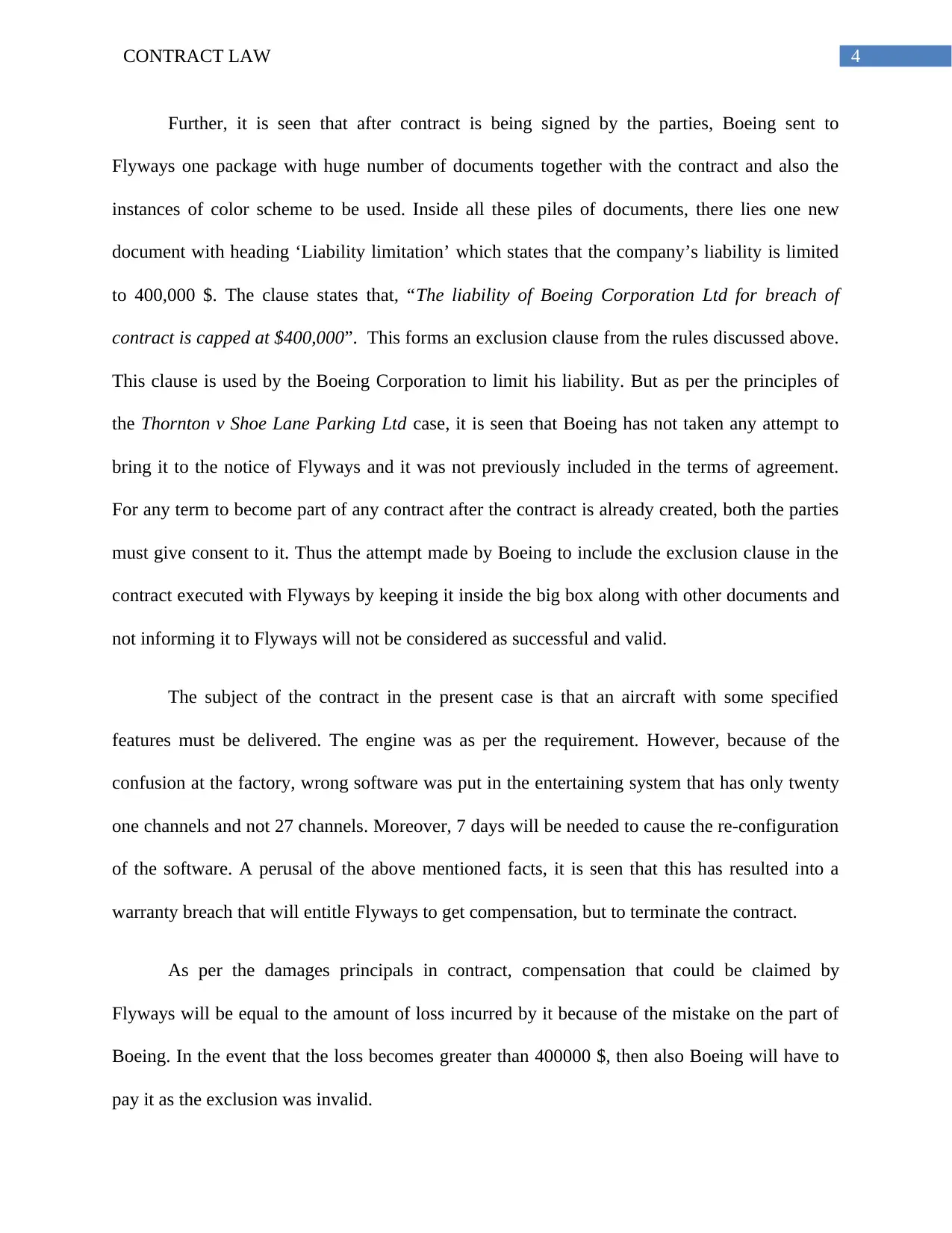
4CONTRACT LAW
Further, it is seen that after contract is being signed by the parties, Boeing sent to
Flyways one package with huge number of documents together with the contract and also the
instances of color scheme to be used. Inside all these piles of documents, there lies one new
document with heading ‘Liability limitation’ which states that the company’s liability is limited
to 400,000 $. The clause states that, “The liability of Boeing Corporation Ltd for breach of
contract is capped at $400,000”. This forms an exclusion clause from the rules discussed above.
This clause is used by the Boeing Corporation to limit his liability. But as per the principles of
the Thornton v Shoe Lane Parking Ltd case, it is seen that Boeing has not taken any attempt to
bring it to the notice of Flyways and it was not previously included in the terms of agreement.
For any term to become part of any contract after the contract is already created, both the parties
must give consent to it. Thus the attempt made by Boeing to include the exclusion clause in the
contract executed with Flyways by keeping it inside the big box along with other documents and
not informing it to Flyways will not be considered as successful and valid.
The subject of the contract in the present case is that an aircraft with some specified
features must be delivered. The engine was as per the requirement. However, because of the
confusion at the factory, wrong software was put in the entertaining system that has only twenty
one channels and not 27 channels. Moreover, 7 days will be needed to cause the re-configuration
of the software. A perusal of the above mentioned facts, it is seen that this has resulted into a
warranty breach that will entitle Flyways to get compensation, but to terminate the contract.
As per the damages principals in contract, compensation that could be claimed by
Flyways will be equal to the amount of loss incurred by it because of the mistake on the part of
Boeing. In the event that the loss becomes greater than 400000 $, then also Boeing will have to
pay it as the exclusion was invalid.
Further, it is seen that after contract is being signed by the parties, Boeing sent to
Flyways one package with huge number of documents together with the contract and also the
instances of color scheme to be used. Inside all these piles of documents, there lies one new
document with heading ‘Liability limitation’ which states that the company’s liability is limited
to 400,000 $. The clause states that, “The liability of Boeing Corporation Ltd for breach of
contract is capped at $400,000”. This forms an exclusion clause from the rules discussed above.
This clause is used by the Boeing Corporation to limit his liability. But as per the principles of
the Thornton v Shoe Lane Parking Ltd case, it is seen that Boeing has not taken any attempt to
bring it to the notice of Flyways and it was not previously included in the terms of agreement.
For any term to become part of any contract after the contract is already created, both the parties
must give consent to it. Thus the attempt made by Boeing to include the exclusion clause in the
contract executed with Flyways by keeping it inside the big box along with other documents and
not informing it to Flyways will not be considered as successful and valid.
The subject of the contract in the present case is that an aircraft with some specified
features must be delivered. The engine was as per the requirement. However, because of the
confusion at the factory, wrong software was put in the entertaining system that has only twenty
one channels and not 27 channels. Moreover, 7 days will be needed to cause the re-configuration
of the software. A perusal of the above mentioned facts, it is seen that this has resulted into a
warranty breach that will entitle Flyways to get compensation, but to terminate the contract.
As per the damages principals in contract, compensation that could be claimed by
Flyways will be equal to the amount of loss incurred by it because of the mistake on the part of
Boeing. In the event that the loss becomes greater than 400000 $, then also Boeing will have to
pay it as the exclusion was invalid.
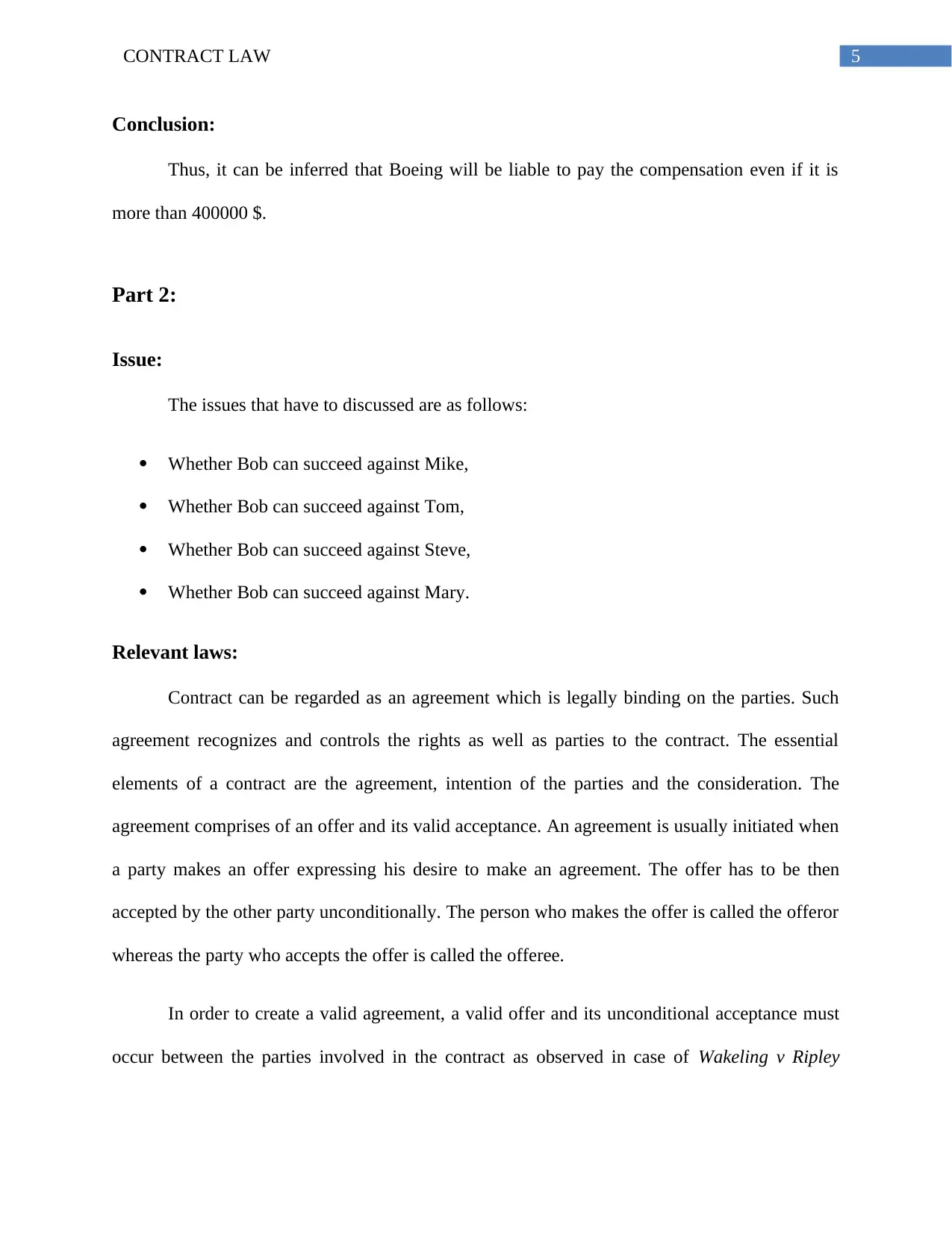
5CONTRACT LAW
Conclusion:
Thus, it can be inferred that Boeing will be liable to pay the compensation even if it is
more than 400000 $.
Part 2:
Issue:
The issues that have to discussed are as follows:
Whether Bob can succeed against Mike,
Whether Bob can succeed against Tom,
Whether Bob can succeed against Steve,
Whether Bob can succeed against Mary.
Relevant laws:
Contract can be regarded as an agreement which is legally binding on the parties. Such
agreement recognizes and controls the rights as well as parties to the contract. The essential
elements of a contract are the agreement, intention of the parties and the consideration. The
agreement comprises of an offer and its valid acceptance. An agreement is usually initiated when
a party makes an offer expressing his desire to make an agreement. The offer has to be then
accepted by the other party unconditionally. The person who makes the offer is called the offeror
whereas the party who accepts the offer is called the offeree.
In order to create a valid agreement, a valid offer and its unconditional acceptance must
occur between the parties involved in the contract as observed in case of Wakeling v Ripley
Conclusion:
Thus, it can be inferred that Boeing will be liable to pay the compensation even if it is
more than 400000 $.
Part 2:
Issue:
The issues that have to discussed are as follows:
Whether Bob can succeed against Mike,
Whether Bob can succeed against Tom,
Whether Bob can succeed against Steve,
Whether Bob can succeed against Mary.
Relevant laws:
Contract can be regarded as an agreement which is legally binding on the parties. Such
agreement recognizes and controls the rights as well as parties to the contract. The essential
elements of a contract are the agreement, intention of the parties and the consideration. The
agreement comprises of an offer and its valid acceptance. An agreement is usually initiated when
a party makes an offer expressing his desire to make an agreement. The offer has to be then
accepted by the other party unconditionally. The person who makes the offer is called the offeror
whereas the party who accepts the offer is called the offeree.
In order to create a valid agreement, a valid offer and its unconditional acceptance must
occur between the parties involved in the contract as observed in case of Wakeling v Ripley
⊘ This is a preview!⊘
Do you want full access?
Subscribe today to unlock all pages.

Trusted by 1+ million students worldwide
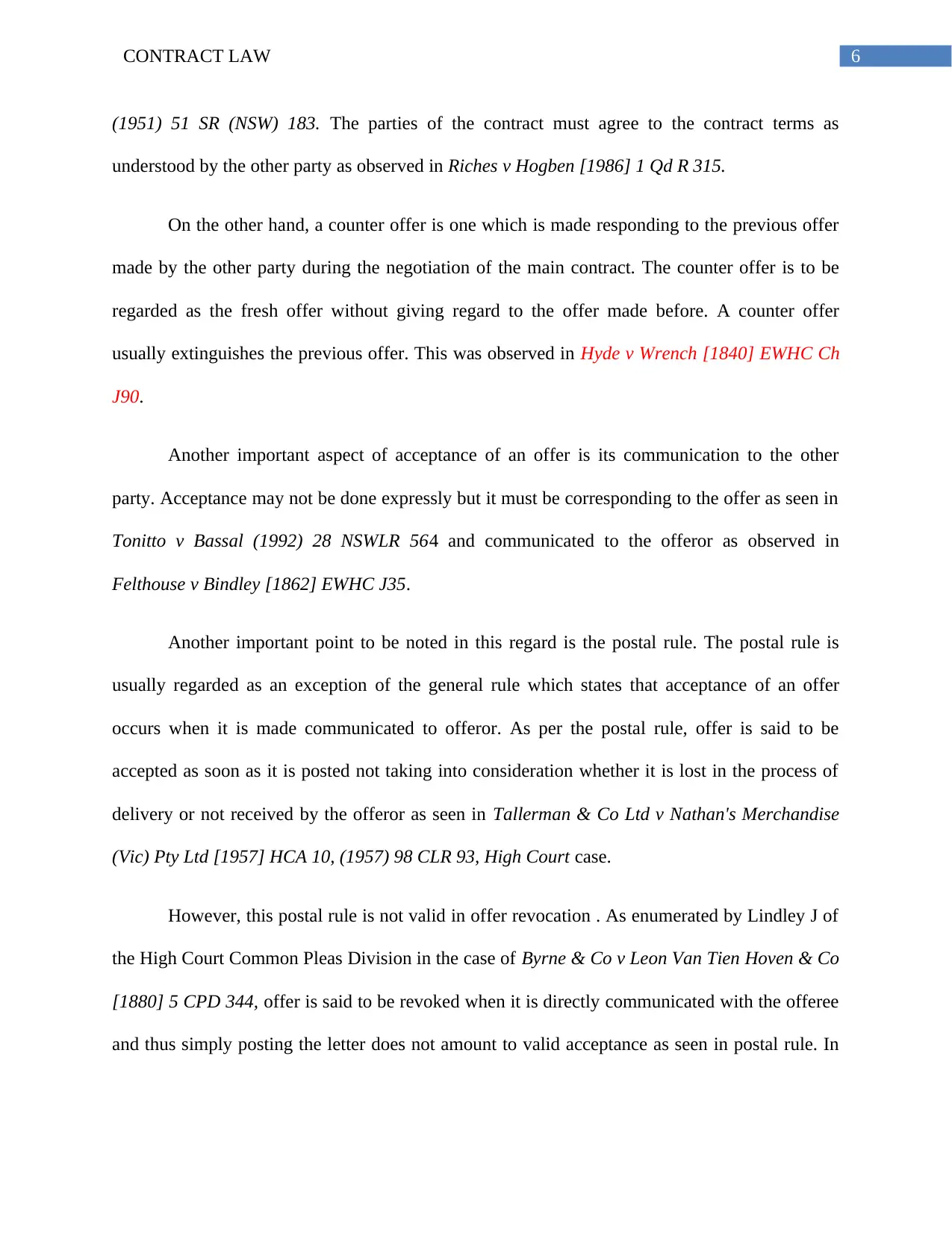
6CONTRACT LAW
(1951) 51 SR (NSW) 183. The parties of the contract must agree to the contract terms as
understood by the other party as observed in Riches v Hogben [1986] 1 Qd R 315.
On the other hand, a counter offer is one which is made responding to the previous offer
made by the other party during the negotiation of the main contract. The counter offer is to be
regarded as the fresh offer without giving regard to the offer made before. A counter offer
usually extinguishes the previous offer. This was observed in Hyde v Wrench [1840] EWHC Ch
J90.
Another important aspect of acceptance of an offer is its communication to the other
party. Acceptance may not be done expressly but it must be corresponding to the offer as seen in
Tonitto v Bassal (1992) 28 NSWLR 564 and communicated to the offeror as observed in
Felthouse v Bindley [1862] EWHC J35.
Another important point to be noted in this regard is the postal rule. The postal rule is
usually regarded as an exception of the general rule which states that acceptance of an offer
occurs when it is made communicated to offeror. As per the postal rule, offer is said to be
accepted as soon as it is posted not taking into consideration whether it is lost in the process of
delivery or not received by the offeror as seen in Tallerman & Co Ltd v Nathan's Merchandise
(Vic) Pty Ltd [1957] HCA 10, (1957) 98 CLR 93, High Court case.
However, this postal rule is not valid in offer revocation . As enumerated by Lindley J of
the High Court Common Pleas Division in the case of Byrne & Co v Leon Van Tien Hoven & Co
[1880] 5 CPD 344, offer is said to be revoked when it is directly communicated with the offeree
and thus simply posting the letter does not amount to valid acceptance as seen in postal rule. In
(1951) 51 SR (NSW) 183. The parties of the contract must agree to the contract terms as
understood by the other party as observed in Riches v Hogben [1986] 1 Qd R 315.
On the other hand, a counter offer is one which is made responding to the previous offer
made by the other party during the negotiation of the main contract. The counter offer is to be
regarded as the fresh offer without giving regard to the offer made before. A counter offer
usually extinguishes the previous offer. This was observed in Hyde v Wrench [1840] EWHC Ch
J90.
Another important aspect of acceptance of an offer is its communication to the other
party. Acceptance may not be done expressly but it must be corresponding to the offer as seen in
Tonitto v Bassal (1992) 28 NSWLR 564 and communicated to the offeror as observed in
Felthouse v Bindley [1862] EWHC J35.
Another important point to be noted in this regard is the postal rule. The postal rule is
usually regarded as an exception of the general rule which states that acceptance of an offer
occurs when it is made communicated to offeror. As per the postal rule, offer is said to be
accepted as soon as it is posted not taking into consideration whether it is lost in the process of
delivery or not received by the offeror as seen in Tallerman & Co Ltd v Nathan's Merchandise
(Vic) Pty Ltd [1957] HCA 10, (1957) 98 CLR 93, High Court case.
However, this postal rule is not valid in offer revocation . As enumerated by Lindley J of
the High Court Common Pleas Division in the case of Byrne & Co v Leon Van Tien Hoven & Co
[1880] 5 CPD 344, offer is said to be revoked when it is directly communicated with the offeree
and thus simply posting the letter does not amount to valid acceptance as seen in postal rule. In
Paraphrase This Document
Need a fresh take? Get an instant paraphrase of this document with our AI Paraphraser

7CONTRACT LAW
this regard, Adams v Lindsell (1818) 1 B & Ald 681case can be referred which can be referred
that provides the postal rule of acceptance of offer.
Another important aspect of any contract is consideration. A contract without
consideration is not enforceable as seen in Australian Woollen Mills Pty Ltd v The
Commonwealth [1954] HCA 20, (1954) 92 CLR 424, High Court. Consideration can be in the
form of money or a promise. But a past consideration cannot be regarded as a sufficient
consideration as seen in Roscorla v Thomas [1842] EWHC J74, (1842) 3 QB 234. However, past
service will be considered only when it is performed at the promisor’s request implying that it
will act as a sufficient consideration for a future promise for paying it as seen in Stewart v Casey
[1892] 1 Ch 104.
Another important case to be discussed in this regard is L'Estrange v F Graucob Ltd
[1934] 2 KB 294. This case controls the signature impact in the contract law that states that one
party will be bound by the contract terms once it has been signed without giving regard to the
fact whether the parties have read it or understand it.
Application:
In case of Bob and Mike, it is seen that Mike Jones sends an email on 1st January, to Bob
stating that he wants to buy Toshiba laptops at the price of 300 $ including the GST. This forms
a valid offer of Mike as he has clear intention to enter into a contract with Bob. On 2nd January,
Bob replied to Mike in an email stating that he is accepting the offer but the price he demands is
300$ with GST additionally. This email from Bob does not amount to acceptance from his part
instead it amounts to a counter offer. This counter offer extinguishes the original offer made by
Bob as observed in the case of Hyde v Wrench [1840] EWHC Ch J90.
this regard, Adams v Lindsell (1818) 1 B & Ald 681case can be referred which can be referred
that provides the postal rule of acceptance of offer.
Another important aspect of any contract is consideration. A contract without
consideration is not enforceable as seen in Australian Woollen Mills Pty Ltd v The
Commonwealth [1954] HCA 20, (1954) 92 CLR 424, High Court. Consideration can be in the
form of money or a promise. But a past consideration cannot be regarded as a sufficient
consideration as seen in Roscorla v Thomas [1842] EWHC J74, (1842) 3 QB 234. However, past
service will be considered only when it is performed at the promisor’s request implying that it
will act as a sufficient consideration for a future promise for paying it as seen in Stewart v Casey
[1892] 1 Ch 104.
Another important case to be discussed in this regard is L'Estrange v F Graucob Ltd
[1934] 2 KB 294. This case controls the signature impact in the contract law that states that one
party will be bound by the contract terms once it has been signed without giving regard to the
fact whether the parties have read it or understand it.
Application:
In case of Bob and Mike, it is seen that Mike Jones sends an email on 1st January, to Bob
stating that he wants to buy Toshiba laptops at the price of 300 $ including the GST. This forms
a valid offer of Mike as he has clear intention to enter into a contract with Bob. On 2nd January,
Bob replied to Mike in an email stating that he is accepting the offer but the price he demands is
300$ with GST additionally. This email from Bob does not amount to acceptance from his part
instead it amounts to a counter offer. This counter offer extinguishes the original offer made by
Bob as observed in the case of Hyde v Wrench [1840] EWHC Ch J90.
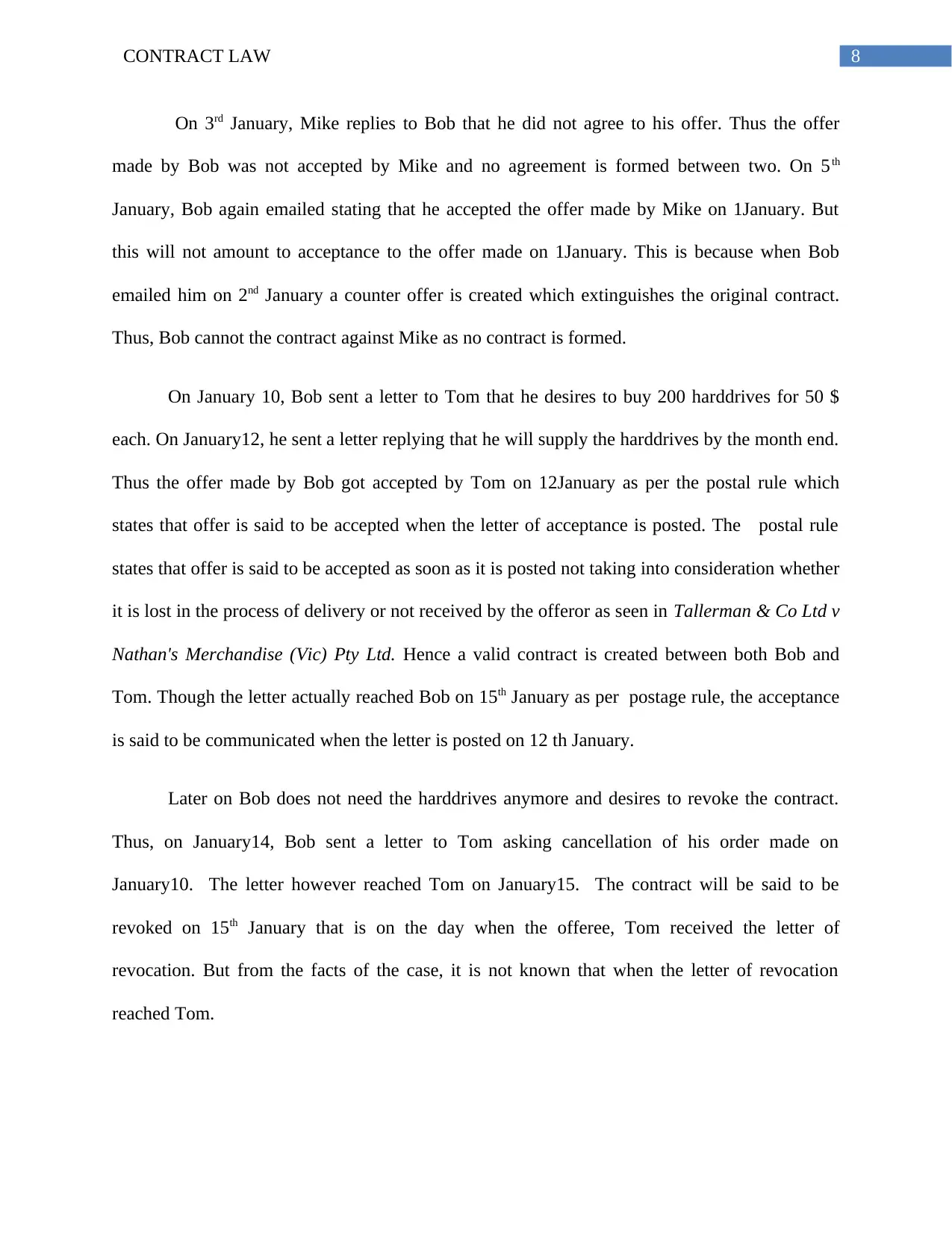
8CONTRACT LAW
On 3rd January, Mike replies to Bob that he did not agree to his offer. Thus the offer
made by Bob was not accepted by Mike and no agreement is formed between two. On 5th
January, Bob again emailed stating that he accepted the offer made by Mike on 1January. But
this will not amount to acceptance to the offer made on 1January. This is because when Bob
emailed him on 2nd January a counter offer is created which extinguishes the original contract.
Thus, Bob cannot the contract against Mike as no contract is formed.
On January 10, Bob sent a letter to Tom that he desires to buy 200 harddrives for 50 $
each. On January12, he sent a letter replying that he will supply the harddrives by the month end.
Thus the offer made by Bob got accepted by Tom on 12January as per the postal rule which
states that offer is said to be accepted when the letter of acceptance is posted. The postal rule
states that offer is said to be accepted as soon as it is posted not taking into consideration whether
it is lost in the process of delivery or not received by the offeror as seen in Tallerman & Co Ltd v
Nathan's Merchandise (Vic) Pty Ltd. Hence a valid contract is created between both Bob and
Tom. Though the letter actually reached Bob on 15th January as per postage rule, the acceptance
is said to be communicated when the letter is posted on 12 th January.
Later on Bob does not need the harddrives anymore and desires to revoke the contract.
Thus, on January14, Bob sent a letter to Tom asking cancellation of his order made on
January10. The letter however reached Tom on January15. The contract will be said to be
revoked on 15th January that is on the day when the offeree, Tom received the letter of
revocation. But from the facts of the case, it is not known that when the letter of revocation
reached Tom.
On 3rd January, Mike replies to Bob that he did not agree to his offer. Thus the offer
made by Bob was not accepted by Mike and no agreement is formed between two. On 5th
January, Bob again emailed stating that he accepted the offer made by Mike on 1January. But
this will not amount to acceptance to the offer made on 1January. This is because when Bob
emailed him on 2nd January a counter offer is created which extinguishes the original contract.
Thus, Bob cannot the contract against Mike as no contract is formed.
On January 10, Bob sent a letter to Tom that he desires to buy 200 harddrives for 50 $
each. On January12, he sent a letter replying that he will supply the harddrives by the month end.
Thus the offer made by Bob got accepted by Tom on 12January as per the postal rule which
states that offer is said to be accepted when the letter of acceptance is posted. The postal rule
states that offer is said to be accepted as soon as it is posted not taking into consideration whether
it is lost in the process of delivery or not received by the offeror as seen in Tallerman & Co Ltd v
Nathan's Merchandise (Vic) Pty Ltd. Hence a valid contract is created between both Bob and
Tom. Though the letter actually reached Bob on 15th January as per postage rule, the acceptance
is said to be communicated when the letter is posted on 12 th January.
Later on Bob does not need the harddrives anymore and desires to revoke the contract.
Thus, on January14, Bob sent a letter to Tom asking cancellation of his order made on
January10. The letter however reached Tom on January15. The contract will be said to be
revoked on 15th January that is on the day when the offeree, Tom received the letter of
revocation. But from the facts of the case, it is not known that when the letter of revocation
reached Tom.
⊘ This is a preview!⊘
Do you want full access?
Subscribe today to unlock all pages.

Trusted by 1+ million students worldwide
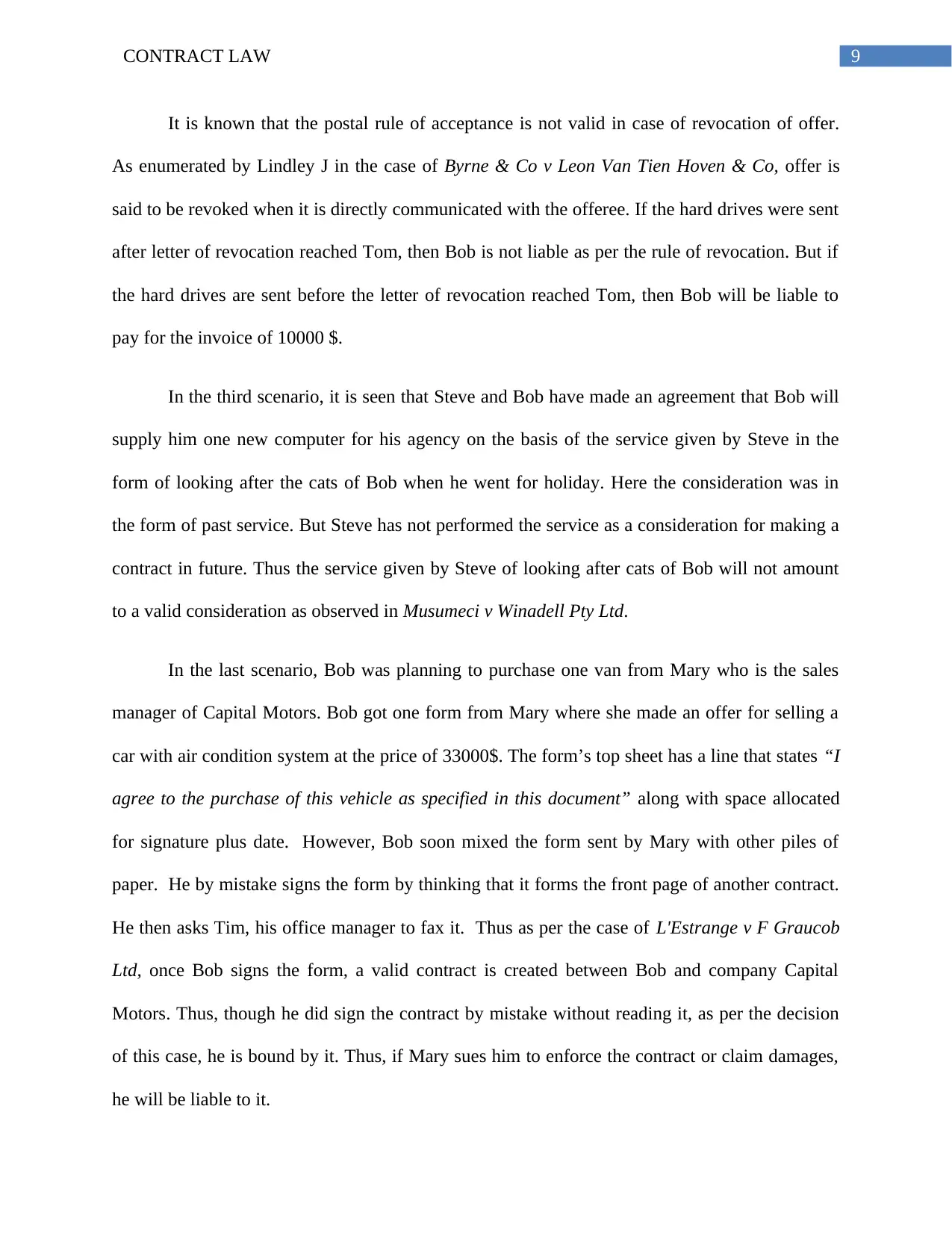
9CONTRACT LAW
It is known that the postal rule of acceptance is not valid in case of revocation of offer.
As enumerated by Lindley J in the case of Byrne & Co v Leon Van Tien Hoven & Co, offer is
said to be revoked when it is directly communicated with the offeree. If the hard drives were sent
after letter of revocation reached Tom, then Bob is not liable as per the rule of revocation. But if
the hard drives are sent before the letter of revocation reached Tom, then Bob will be liable to
pay for the invoice of 10000 $.
In the third scenario, it is seen that Steve and Bob have made an agreement that Bob will
supply him one new computer for his agency on the basis of the service given by Steve in the
form of looking after the cats of Bob when he went for holiday. Here the consideration was in
the form of past service. But Steve has not performed the service as a consideration for making a
contract in future. Thus the service given by Steve of looking after cats of Bob will not amount
to a valid consideration as observed in Musumeci v Winadell Pty Ltd.
In the last scenario, Bob was planning to purchase one van from Mary who is the sales
manager of Capital Motors. Bob got one form from Mary where she made an offer for selling a
car with air condition system at the price of 33000$. The form’s top sheet has a line that states “I
agree to the purchase of this vehicle as specified in this document” along with space allocated
for signature plus date. However, Bob soon mixed the form sent by Mary with other piles of
paper. He by mistake signs the form by thinking that it forms the front page of another contract.
He then asks Tim, his office manager to fax it. Thus as per the case of L'Estrange v F Graucob
Ltd, once Bob signs the form, a valid contract is created between Bob and company Capital
Motors. Thus, though he did sign the contract by mistake without reading it, as per the decision
of this case, he is bound by it. Thus, if Mary sues him to enforce the contract or claim damages,
he will be liable to it.
It is known that the postal rule of acceptance is not valid in case of revocation of offer.
As enumerated by Lindley J in the case of Byrne & Co v Leon Van Tien Hoven & Co, offer is
said to be revoked when it is directly communicated with the offeree. If the hard drives were sent
after letter of revocation reached Tom, then Bob is not liable as per the rule of revocation. But if
the hard drives are sent before the letter of revocation reached Tom, then Bob will be liable to
pay for the invoice of 10000 $.
In the third scenario, it is seen that Steve and Bob have made an agreement that Bob will
supply him one new computer for his agency on the basis of the service given by Steve in the
form of looking after the cats of Bob when he went for holiday. Here the consideration was in
the form of past service. But Steve has not performed the service as a consideration for making a
contract in future. Thus the service given by Steve of looking after cats of Bob will not amount
to a valid consideration as observed in Musumeci v Winadell Pty Ltd.
In the last scenario, Bob was planning to purchase one van from Mary who is the sales
manager of Capital Motors. Bob got one form from Mary where she made an offer for selling a
car with air condition system at the price of 33000$. The form’s top sheet has a line that states “I
agree to the purchase of this vehicle as specified in this document” along with space allocated
for signature plus date. However, Bob soon mixed the form sent by Mary with other piles of
paper. He by mistake signs the form by thinking that it forms the front page of another contract.
He then asks Tim, his office manager to fax it. Thus as per the case of L'Estrange v F Graucob
Ltd, once Bob signs the form, a valid contract is created between Bob and company Capital
Motors. Thus, though he did sign the contract by mistake without reading it, as per the decision
of this case, he is bound by it. Thus, if Mary sues him to enforce the contract or claim damages,
he will be liable to it.
Paraphrase This Document
Need a fresh take? Get an instant paraphrase of this document with our AI Paraphraser
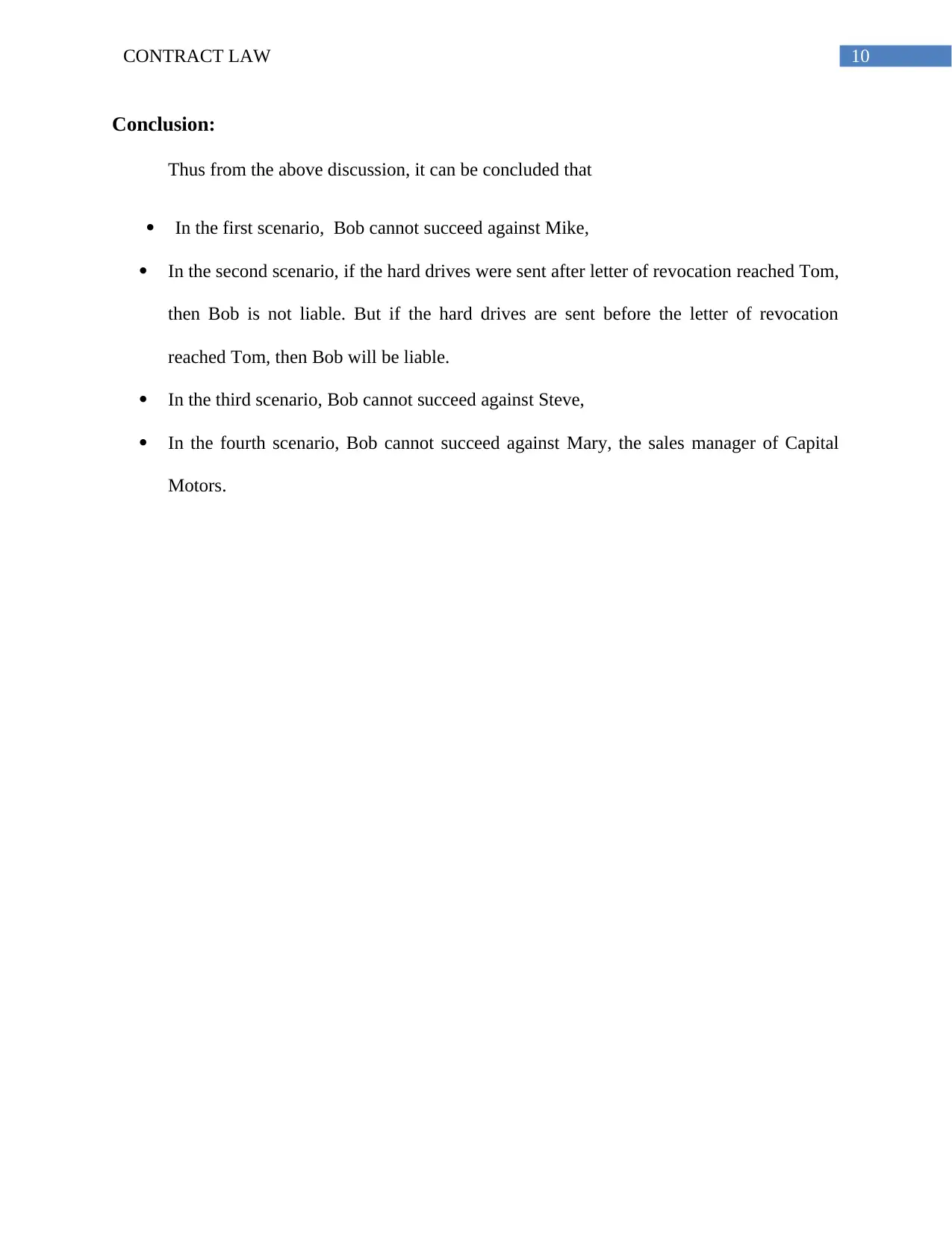
10CONTRACT LAW
Conclusion:
Thus from the above discussion, it can be concluded that
In the first scenario, Bob cannot succeed against Mike,
In the second scenario, if the hard drives were sent after letter of revocation reached Tom,
then Bob is not liable. But if the hard drives are sent before the letter of revocation
reached Tom, then Bob will be liable.
In the third scenario, Bob cannot succeed against Steve,
In the fourth scenario, Bob cannot succeed against Mary, the sales manager of Capital
Motors.
Conclusion:
Thus from the above discussion, it can be concluded that
In the first scenario, Bob cannot succeed against Mike,
In the second scenario, if the hard drives were sent after letter of revocation reached Tom,
then Bob is not liable. But if the hard drives are sent before the letter of revocation
reached Tom, then Bob will be liable.
In the third scenario, Bob cannot succeed against Steve,
In the fourth scenario, Bob cannot succeed against Mary, the sales manager of Capital
Motors.
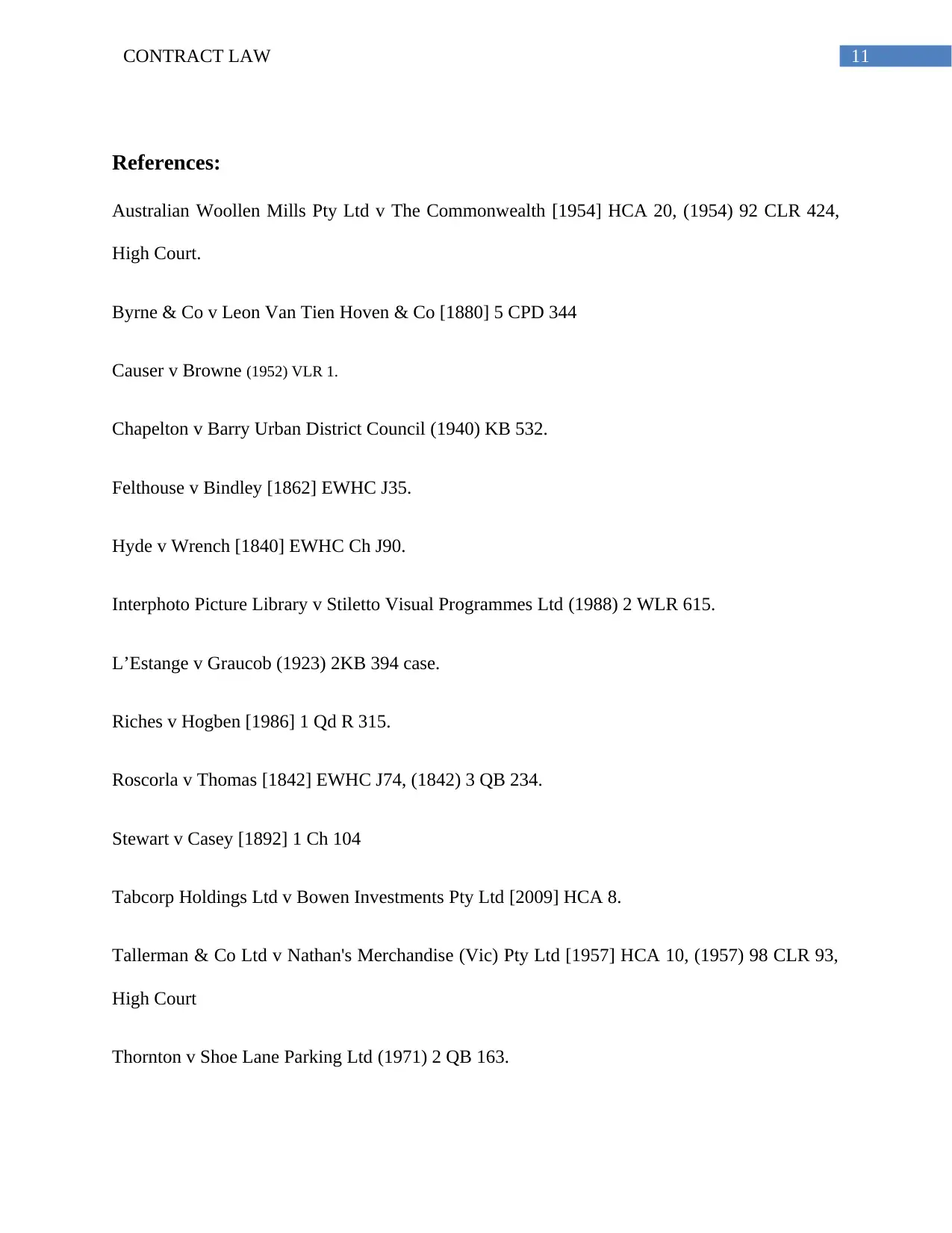
11CONTRACT LAW
References:
Australian Woollen Mills Pty Ltd v The Commonwealth [1954] HCA 20, (1954) 92 CLR 424,
High Court.
Byrne & Co v Leon Van Tien Hoven & Co [1880] 5 CPD 344
Causer v Browne (1952) VLR 1.
Chapelton v Barry Urban District Council (1940) KB 532.
Felthouse v Bindley [1862] EWHC J35.
Hyde v Wrench [1840] EWHC Ch J90.
Interphoto Picture Library v Stiletto Visual Programmes Ltd (1988) 2 WLR 615.
L’Estange v Graucob (1923) 2KB 394 case.
Riches v Hogben [1986] 1 Qd R 315.
Roscorla v Thomas [1842] EWHC J74, (1842) 3 QB 234.
Stewart v Casey [1892] 1 Ch 104
Tabcorp Holdings Ltd v Bowen Investments Pty Ltd [2009] HCA 8.
Tallerman & Co Ltd v Nathan's Merchandise (Vic) Pty Ltd [1957] HCA 10, (1957) 98 CLR 93,
High Court
Thornton v Shoe Lane Parking Ltd (1971) 2 QB 163.
References:
Australian Woollen Mills Pty Ltd v The Commonwealth [1954] HCA 20, (1954) 92 CLR 424,
High Court.
Byrne & Co v Leon Van Tien Hoven & Co [1880] 5 CPD 344
Causer v Browne (1952) VLR 1.
Chapelton v Barry Urban District Council (1940) KB 532.
Felthouse v Bindley [1862] EWHC J35.
Hyde v Wrench [1840] EWHC Ch J90.
Interphoto Picture Library v Stiletto Visual Programmes Ltd (1988) 2 WLR 615.
L’Estange v Graucob (1923) 2KB 394 case.
Riches v Hogben [1986] 1 Qd R 315.
Roscorla v Thomas [1842] EWHC J74, (1842) 3 QB 234.
Stewart v Casey [1892] 1 Ch 104
Tabcorp Holdings Ltd v Bowen Investments Pty Ltd [2009] HCA 8.
Tallerman & Co Ltd v Nathan's Merchandise (Vic) Pty Ltd [1957] HCA 10, (1957) 98 CLR 93,
High Court
Thornton v Shoe Lane Parking Ltd (1971) 2 QB 163.
⊘ This is a preview!⊘
Do you want full access?
Subscribe today to unlock all pages.

Trusted by 1+ million students worldwide
1 out of 13
Related Documents
Your All-in-One AI-Powered Toolkit for Academic Success.
+13062052269
info@desklib.com
Available 24*7 on WhatsApp / Email
![[object Object]](/_next/static/media/star-bottom.7253800d.svg)
Unlock your academic potential
Copyright © 2020–2025 A2Z Services. All Rights Reserved. Developed and managed by ZUCOL.





